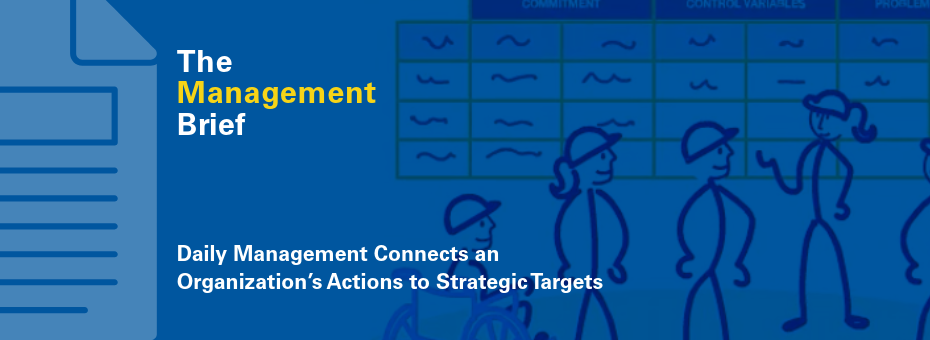This month’s The Management Brief featured a mix of voices describing daily management and its relationship to strategy: an LEI coach/industrial engineer who also is regularly engaged with daily management in a healthcare system; a CEO and president who is championing daily management in his growing, family-owned enterprise; and lean leaders who have been involved with and studied daily management for years.
All of these unique perspectives help to illustrate the power of daily management in supporting an organization’s higher goals. In Managing On Purpose, I wrote that a daily management system is a key enabler of strategic planning—i.e., hoshin kanri. “A daily management system that can identify operational problems and address them quickly will help your hoshin efforts. Absent this (where firefighting dominates managers’ workloads) it will be difficult for leaders to maintain a structured hoshin process. A robust daily management system frees up time for all involved for both the work of hoshin kanri and performing their daily roles.” The May participants in The Management Brief bring this thinking to life.
The Successful, Continuous Beat of Daily Management
Josh Howell, LEI president, explored the topic of daily management with Joe Seestadt, Director Lab Outreach for Bronson Healthcare and a faculty member and coach with LEI. Joe, trained as an industrial engineer, has spent some 18 years in healthcare. He is both a lean guide to others as well as an owner and user of the systems and concepts that he’s helping individuals grasp as they try to change their own organizations.
After working in manufacturing at Kaiser Aluminum and Delphi, Joe moved on to healthcare. At the Cleveland Clinic about a decade ago, Joe became the operational leader for Pathology and Laboratory Medicine. With 1,600 employees reporting up to him, he worked to put a large-scale daily management system in place, one that ultimately spread across the organization and has been recognized industrywide.
“I saw daily management as a key system that I needed to put in place to survive in this role,” said Joe. “Daily management for me was something that would give me several things: One, the visibility of problems. Coming from outside the lab industry, I did not know the processes the same way as people who grew up in the industry did, and I needed to be able to see problems and I needed my team to as well. Second, I needed to be able to know if we were ahead or behind, winning or losing every single day. And third, I had to have an ability to have issues bubble up, get discussed, and resolved, and then communications come back down on an everyday basis.”
Working in a doctor-led organization, he found he had to use the powers of influence and not control to get physicians to support the system as it got underway, and as the architect of the system he also had to be rigorous in its use, such as always attending daily huddles.
Joe said daily management is “a way to be proactive with your reactive issues” by committing to get together for a short period of time every day and looking at the most critical things—as opposed to randomly responding to disruptive issues in an unscientific manner. He said several elements make a daily management system work well:
- Conducting a daily huddle around an erasable whiteboard near where the work is done
- Ability to trend data that is reviewed and compare to prior periods
- Capability of the individual running the huddle to understand what kind of conversation is occurring (something that can be resolved in the next minute, an issue that should be tracked for future observation, or a problem to solve that is worthy of A3 problem-solving)
- Ability to problem-solve
- Connection to strategy (KPIs from hoshin are among things reviewed daily)
- Ability to prioritize the problem-solving efforts that will be worked on and escalate issues and communicate resolutions in a tiered management system.
Compared to his work at the Cleveland Clinic and prior, Joe said daily management is much more pervasive today in healthcare and other industries. Over the last several years, he’s also seen the importance of discipline and consistency of the structure of daily management, such as sticking to the daily frequency and maintaining the brevity of huddles. “Keep it going consistently every day.”
Executing Strategy through Daily Management
José Ferro and Robson Gouveia, co-authors of Daily Management to Execute Strategy and President and Director of the Lean Institute Brazil, respectively, wrote that strategies often fail because they are not effectively communicated, cascaded, and monitored from all levels of the organization. Daily management addresses this by establishing clear alignment and commitment across all the layers and functions and “creates a structured rhythm of accountability and visibility that keeps everyone focused on what matters most.”
José and Robson offered clear instructions for designing and implementing a daily management system. They identified seven characteristics of a daily management system that ensures strategic objectives are achieved and three main blocks upon which a system should be built:
- Commitment to daily management clearly and explicitly connects each area in an organization to strategic priorities.
- Control variables are daily goals that represent the value to be delivered each day, with teams comparing planned goals with the actual results and addressing any gaps.
- Problem-solving powers daily management by enabling teams to visualize the issues they are currently tackling, those pending action, or those that require escalation for further support.
“Daily management encourages every person to connect their daily work to the hoshin objectives, not occasionally, but consistently,” wrote José and Robson. “While hoshin kanri sets the direction across the entire organization, daily management ensures that progress happens every single day. It brings clarity to what a good day looks like and enables teams to see, in real time, whether they are winning or losing.”
Lean Improvements Lead to Improved Lean Planning and Management
In this podcast I joined Karen Gaudet, LEI Senior Coach, and Michael Duncan, CEO and President of Viwinco. We discussed Michael’s efforts to establish a robust daily management system in the family-owned window and door company and connect it to the company’s hoshin kanri process.
Michael grew up in the company; his father was the first Viwinco employee and general manager for 35 years. Michael spent his early adulthood being exposed to many internal aspects of the business prior to college and then returned to the company. He spent three years in customer service, moved to marketing and R&D, and then quickly rose to general manager. All the internal learning and customer-facing experiences gave him a well-balanced view of how to lead Viwinco and what was needed to grow.
As company leader, Michael spearheaded the company’s lean transformation that enabled it to more efficiently manage its challenging business model of customized products, varying demand, short lead times, and no finished-goods inventory. “Everything we made yesterday got loaded on a truck yesterday and shipped to customers today. Our most basic product line has over 200 million variations.”
He described the “messy” challenge of implementing lean while building capabilities of staff, and the outcomes achieved: performance to the customer, quality, and people capability improved quickly, and the company has been able to double sales in five years and significantly improve profits and value of the company. He’s now leading Viwinco’s application of hoshin kanri and daily management.
“Learning about management systems and how to implement that has been a component that has helped drive improvement… Now we’re starting to get into a much more strategic planning process with hoshin kanri,” said Michael. Included in this next wave of lean progress has been the application of daily management, which Michael defined as the “cadence and structure to help management performance, whether it’s our KPIs we’re tracking or our strategic projects… There’s different pieces of that. There’s the daily components, weekly components, and the monthly components that all kind of connect together.”
He said it’s important to relentlessly follow the cadence every day, especially when starting with daily management. This adherence allows the company to constantly track and connect their KPIs from the frontline up to leadership—the construct of a “KPI tree” that provides confidence that metrics and daily management outputs are consistent across the organization.
Karen has supported Viwinco for three years and credited Michael and his leadership team with complete engagement from the beginning as they developed their capability to self-reflect, put strategies in place, and help others problem-solve. She pointed out that establishing daily management is no quick or easy task: When Viwinco first started trying to design daily management, starting with the morning huddle on each line and what was tracked and who was involved, it took approximately a year to get the basic structure in place with the right stakeholders, ready and useful information, and methods to escalate problems out of huddles. She said Viwinco eventually developed a tenacious rigor and is now fine-tuning the quality of the data and what is done with the data, connecting the process and information up through the organization to the company’s strategy.
“If you go back five years ago, our company strategy was a 20-page Word document built solely by me and maybe with some input from the executive team,” said Michael. “It’s been a couple-year journey where we’ve started getting more structured and simplifying the strategy, making it visible, building a management system around how to advance the strategy. This year was the first step in a much more structured approach to the input processes to building the strategy through hoshin kanri.”
The company created a five-year vision and modified strategy inputs to include customer feedback, KPI review, benchmarking, structured reflection of last year’s strategy, and SWOT analysis. The executive team identified three clear problems to achieving the vision, and solving those issues became the hoshin strategy for the year. To support the dissemination and execution of the strategy, horizontal and vertical catchball processes were initiated around activities and targets. “That was something we had never done in the past. That was really helpful in letting everybody know what we are trying to do this year and then getting feedback from the people actually responsible for doing the work.”
Michael also discussed the need for the company to continue to grow and leverage lean to innovate and speed up the pace at which the company can grow, expand, and continue to thrive in Morgantown, PA, amid industry consolidation. “That’s how we’re going to differentiate vs. the large corporations—the pace at which we can move and bring fresh ideas to the table. Lean has helped us, and we need to continue to progress and improve in that regard.”
Next Month
The June releases of The Management Brief will focus on problem-solving.
The Management Brief is a weekly newsletter from the Lean Enterprise Institute that bridges the gap between theory and practice in lean management. Designed for leaders focused on long-term success, it delivers actionable insights, expert perspectives, and stories from real-world practitioners. Each edition explores the principles of lean management—strategy deployment (hoshin kanri), operational stability and continuous improvement (daily management), and problem-solving (A3)—while highlighting the critical role of leadership. Subscribe to join a growing community of leaders dedicated to creating organizations built for sustained excellence.
The Lean Management Program
Build the capability to lead and sustain Lean Enterprises




